Have you ever wondered what it is like to work for Ribble Rivers Trust? Out latest recruit Alice has documented her first few weeks here at the Trust, giving us all the details on what its like to be kicking off a career in conservation!
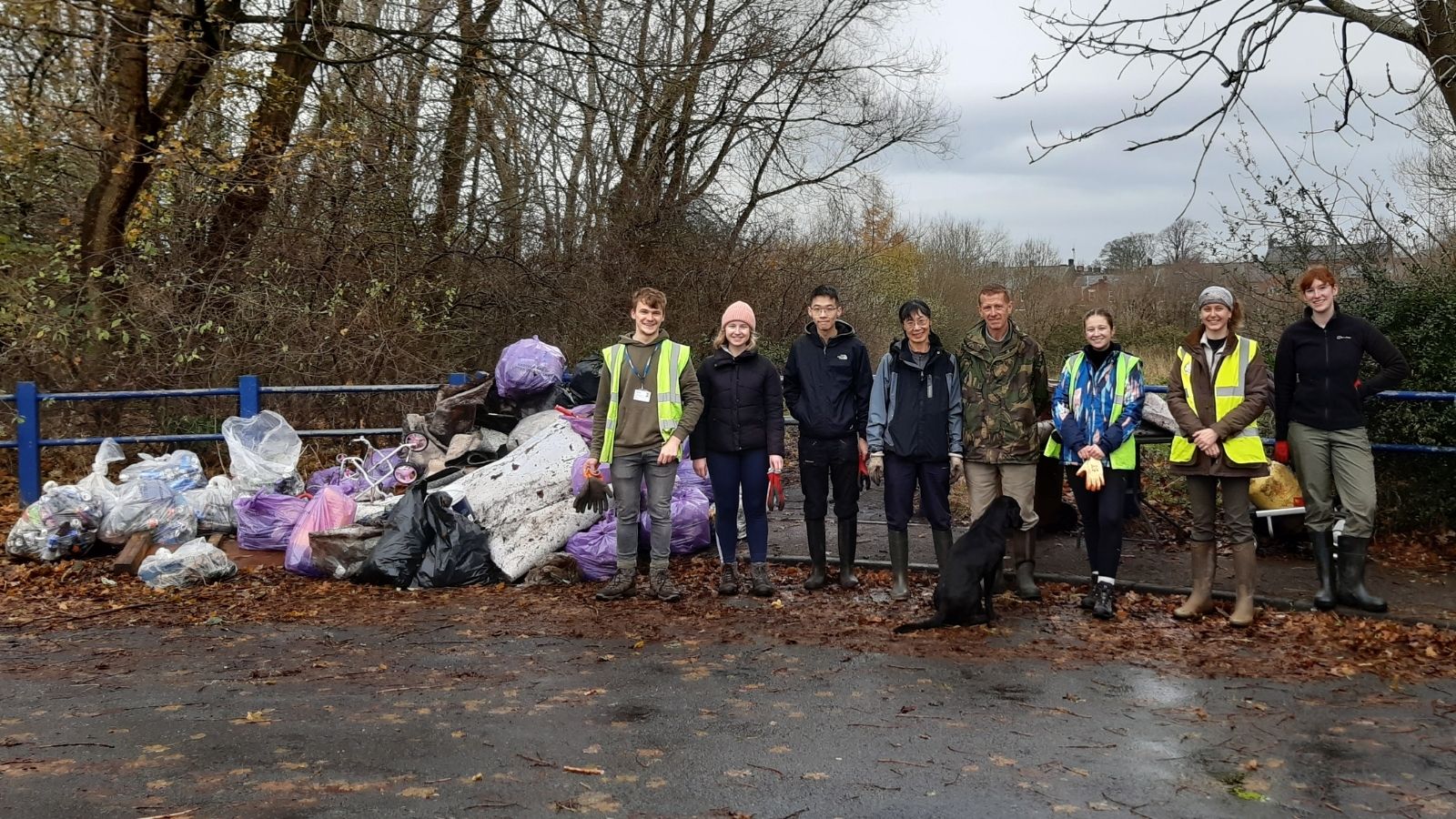
Hello! My name is Alice and I’ve recently joined Ribble Rivers Trust as an Assistant Project Officer for the HEAL (Health & Environmental Action Lancashire) project which began in September 2021. Prior to my current role, I was a Project Management Assistant at Network Rail for four years; delivering fencing and level crossing renewals across the North-West. I am currently studying a part-time master’s degree in Conservation Management at Edge Hill University. This has given me a lot of in-depth knowledge about conservation, ecology and land management. In this blog post I will be taking about some of the things that I’ve been up to and the projects I’ve worked on during my first few weeks working with the team.
Making planters for the micro tree nurseries
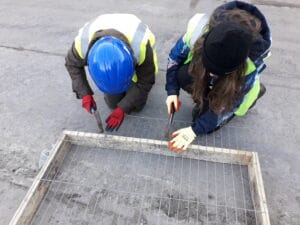
During my first week, Ellie, the three River Conservation Trainees and I built some of the planters for the micro tree nurseries. These will be installed as part of the HEAL project. These planters will hold the young trees, allowing them to drain freely and protecting them from small mammals and birds.
These brand-new nurseries will provide a wonderful opportunity for volunteers in local communities to get involved in growing trees. These trees will then be planted at woodland creation sites across the Ribble catchment that contribute towards the health of our rivers. These nurseries will be especially important for people who may not be able to take part in other voluntary activities. The nurseries will be easily accessible by public transport and are set up for a wide variety of people of all abilities to use.
We did a great job working together to build several sturdy planters out of donated palettes and heras fencing. They’re now ready to be cleaned and delivered to our sites!
Eaves Brook clean up and site visit to fish passes in Chorley
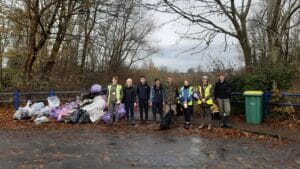
I joined Helen and the River Conservation Trainees for the volunteer event hosted by the trust on Fridays. We met four volunteers to do a clean-up of the green space alongside Eaves Brook in Preston. In the two hours we were there, we cleared a huge amount of litter found amongst the scrub and trees. The volunteers were fantastic. They really got stuck in with the clean-up; going into hard-to-reach places and tackling brambles to pick up as much litter as possible.
In the afternoon, we went to Chorley to look at the fish passes that have been installed as part of the Opening Up the River (OUR) Douglas Project. The fish passes will have information boards installed next to them. This gives members of the public the chance to read about the structures and how they allow fish species to access upstream habitats.
Tree planting in Nelson with Wellocks and William Jackson Food Group
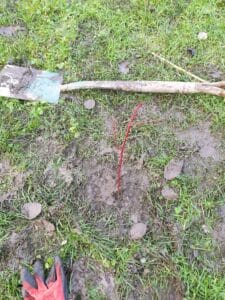
On Thursday, I carried out tree planting with some local businesses in Nelson to start off the first of our HEAL woodlands. We planted a variety of tree species (dogwood, blackthorn, hawthorn, alder, holly etc.) on a large grass verge near the Colne Valley Greenway that runs alongside Colne Water.
This brand-new woodland will have many benefits. It will help reduce surface water runoff, filter and slow the flow of water into the river. The trees will also provide benefits that aren’t specific to rivers; as the section of grass is no longer being mown, the sward will grow and create a new habitat for small mammals, invertebrates, amphibians and birds. The site is adjacent to the M65. In time, the trees will help filter harmful air pollutants from car emissions; shielding pedestrians that use the local green space.
Tour of the local projects and fish passes
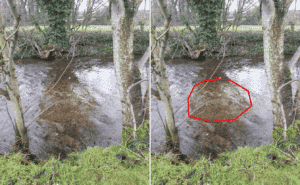
Mike and I went to look at some of the projects that the trust have delivered around the Ribble Valley. We first went to Primrose Nature Reserve, a two-year project which was completed in March 2021. It was amazing to see the number of birds using the site; we saw lots of mallards and grey herons on the wetland, and further upstream we saw a kingfisher fly underneath the bridges. The Alaskan ‘A’ fish pass, that was installed to allow fish and other aquatic species to move past the 7-metre-high dam, was extremely impressive. We spoke about how the fish pass was shown to be successful by capturing and radio tagging individual fish and tracking them as they moved up the fish pass and into the nature reserve above the dam.
After that, we went to look at some other fish passes and weir removals in the area, including Howgill and Smithies Brook. It was interesting to see the variety of fish passes and discuss each of the different elements required for their successful installation. The highlight of the day was seeing an Atlantic Salmon redd for the first time on Smithies Brook. I couldn’t believe how big the redd was. It is wonderful to see that the brook is providing spawning habitat.
Tour of more fish passes and HEAL sites
The day after my visit to the local fish passes around Clitheroe, I visited the two large fish passes on Hyndburn Brook; Oakenshaw and Dunkenhalgh with Adam. We talked about how weir removal is not always possible under certain circumstances. In the case of Oakenshaw, the weir has a large sewer pipe running behind it that cannot be removed. The Dunkenhalgh weir is a 200-year-old structure that has a lot of heritage to the local area.
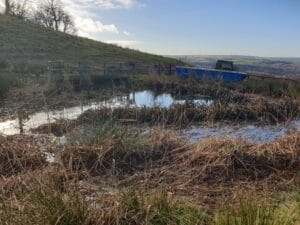
We also went to Slate Pits, located on an upland hill farm near Accrington. This wetland was created in 2018 to create a form of natural flood management that helps reduce flood risk to populated areas downstream. It was helpful to see this site as it gives me an idea of how the wetland being delivered as part of the HEAL project will look and function when it is created in the future, as they will be very similar in design.
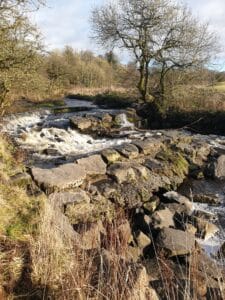
Our final visits of the day took us to Peel Park & the Coppice and Ball Grove Park. These are two sites where work is being delivered as part of the HEAL project. We scoped out the area where footpaths are planning to be installed to allow the space to be more accessible for the general public, including a viewpoint next to a fish pass installed by Trust several years ago.
My first few weeks getting to see and learn about the projects delivered by the Ribble Rivers Trust have been great. Everyone has been so welcoming and happy to take me around the catchment to see the wonderful work they’ve delivered. I’m really looking forward to seeing how the HEAL project progresses and attending the events planned in 2022.
conservation career

